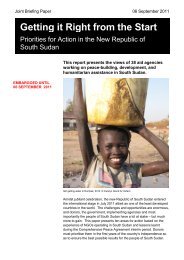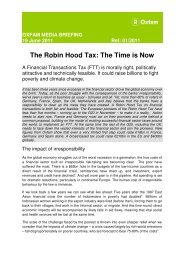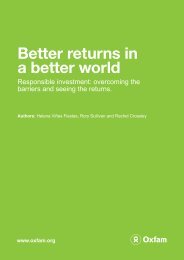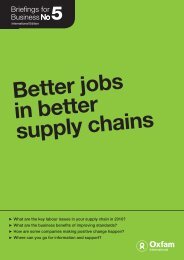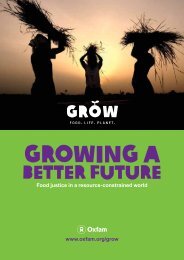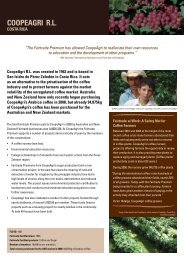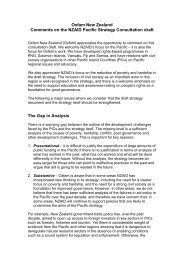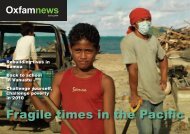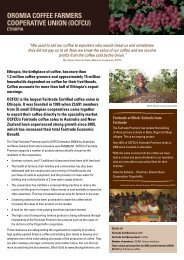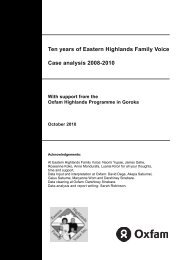4.<strong>The</strong> producers continuedFor a period in <strong>the</strong> 1970s and early 1980s, it was indeed<strong>the</strong> case that banana plantation jobs in many countrieswere seen as <strong>the</strong> best agricultural work. It was a sourceof pride to work in a plantation. Wages wereconsiderably higher than typical agricultural wages, andmany workers were covered by <strong>the</strong> benefits negotiated by<strong>the</strong> independent trade unions <strong>the</strong>y had struggled to formover previous decades. Today however, <strong>the</strong> situation isquite different as a result of <strong>the</strong> never-ending downwardpressure to cut prices and production costs all along <strong>the</strong>supply chain. 20<strong>The</strong> effect on plantation workers in Latin America of <strong>the</strong>drive to cut labour costs and increase productivity hasbeen dramatic and manifold: increasingly casualisedworking relationships; long hours and low wages;anti-trade union activity; intensive use of agrochemicals;poor health and safety standards; and lack of access toproper healthcare. <strong>The</strong>se are described in more detailbelow. In Africa, where costs are lower, <strong>the</strong> medium- andlarge-scale plantations in Cameroon, Cote d’Ivoire andGhana tend to employ more workers per hectare than inLatin America and working conditions are not quite soharsh (although invariably <strong>the</strong>y don’t receive a living wage):in general, working days are not as long and, becausefewer chemicals are applied for climatic reasons, workersare less exposed to pesticides. 214.3 Wages and working conditionsRa<strong>the</strong>r than increasing, banana workers’ wages haveactually fallen dramatically over <strong>the</strong> past 15 years. <strong>The</strong>majority of banana plantation workers do not earn enoughto provide for <strong>the</strong>ir families – some still earn less than £1per day. 22 An eight-hour working day in Costa Rica in1993 would earn a monthly wage of $250. Four yearslater <strong>the</strong> equivalent was just $187, and by 2003 <strong>the</strong>minimum agricultural wage remained <strong>the</strong> same in dollars,while <strong>the</strong> cost of living had nearly doubled. 23 A studycommissioned by <strong>The</strong> Co-operative Group in 2004concluded that Costa Rican workers considered a basic‘living wage’ would be at least 50% higher than <strong>the</strong>typical wage prevailing in plantations. 24 In Ecuador, <strong>the</strong>government’s own figures show that <strong>the</strong> minimumagricultural wage of $160 a month (which is more thanmany workers receive) only buys about a third of <strong>the</strong> basichousehold food basket.<strong>The</strong>re has also been a downward trend in <strong>the</strong> numberof permanent contracts available for workers and <strong>the</strong>increasing use of casual labour and contractors. Thisprocess of hiring workers through o<strong>the</strong>r companies or ona short-term basis enables plantation owners to avoidresponsibility for workers rights. It also often preventsworkers from claiming <strong>the</strong>ir statutory employmentbenefits, or from joining a union, as in Ecuador. 25<strong>The</strong> situation for women workers, who are mainlyemployed in <strong>the</strong> packing-houses, is of particular concernin many producing countries. Many banana companies donot respect basic rights such as maternity leave andregular healthcare and <strong>the</strong>re are no childcare facilities on<strong>the</strong> plantations. 26 In fact employers have been employingfewer and fewer women so as to avoid <strong>the</strong>seresponsibilities. In addition, women are working in aculture that has not historically challenged sexualharassment in <strong>the</strong> workplace. 274.4 <strong>Trade</strong> union powerJoining and forming independent trade unions in order tofight for improved conditions is one of <strong>the</strong> most importantways that workers can secure <strong>the</strong>ir rights. While all <strong>the</strong>banana exporting countries in Latin America have ratified<strong>the</strong> main conventions of <strong>the</strong> International LabourOrganisation (ILO), including <strong>the</strong> freedom to join a union,<strong>the</strong>se conventions are often not enforced on <strong>the</strong> ground.<strong>The</strong> regional coordinating body of banana workers’unions, COLSIBA, estimates that only about 10% of LatinAmerican workers are union members. Of <strong>the</strong>se, wellover half have been able to negotiate collective bargainingagreements – labour contracts that outline <strong>the</strong> agreedoutcomes of collective bargaining negotiations on payand working conditions – with <strong>the</strong>ir employers.An ILO study of banana plantations in Costa Ricaconcluded that ‘trade union organisations are persecutedand repressed. Dismissed for <strong>the</strong>ir trade union activities,workers are placed on blacklists that circulate among <strong>the</strong>plantation owners. <strong>The</strong>y will never find work again.’A more recent ILO report confirms that this situationpersists. 2820Gilberth Bermudez. ‘Working Conditions in Latin American <strong>Banana</strong> Plantations.’ IBC II. 2005.21Communication from <strong>Banana</strong> Link.22‘News from <strong>the</strong> <strong>Banana</strong> Front.’ Issue 11. <strong>Banana</strong> Link. January 2007.23Ibid 17.24‘<strong>The</strong> Real Wage Situation of Male and Female Workers in 11 <strong>Banana</strong> Plantations in Costa Rica, in Comparison to a Living Wage”, ASEPROLA, November 2004.25ITUC Annual Survey of Violations of <strong>Trade</strong> Union Rights 2008.26Preparatory documents for IBC II. 2005.27Ibid 13.28Report of ILO Mission to Costa Rica. 2007.page 8 <strong>Unpeeling</strong> <strong>the</strong> banana trade
Since <strong>the</strong> 1990s, Latin American banana companieshave increasingly relied on cheap migrant labour as a wayof bringing down labour costs. In Belize, owners haverecruited a largely migrant workforce from neighbouringcountries and use <strong>the</strong> threat of deportation wheneverworkers have tried to organise <strong>the</strong>mselves to secureimprovements.In o<strong>the</strong>r countries, Colombia and Guatemala for example,<strong>the</strong> situation is even more serious with reports that tradeunion members and leaders have been systematicallymurdered by private security forces, paramilitaries orguerrilla groups as a means of deterring o<strong>the</strong>rs frombecoming involved in union activities. 29<strong>Fairtrade</strong> standards aim to go fur<strong>the</strong>r than<strong>the</strong> norms of ethical assurance and ourfocus on promoting sustainabledevelopment means that we make adifference by changing situations ra<strong>the</strong>rthan simply certifying a status quo. Ourstandards endorse worker organisationthrough democratic and independenttrade unions as <strong>the</strong> best way of protectinglabour rights, and collective bargaining as<strong>the</strong> best process for agreeing employmentconditions.laws are routinely violated. Indeed employers not onlyignore this legislation, but sometimes discipline workerswho fail to continue working during aerial spraying. Since<strong>the</strong> living quarters of workers (and <strong>the</strong>ir families) are ofteninside or adjacent to <strong>the</strong> plantations, <strong>the</strong>ir homes aresprayed and <strong>the</strong>y consume chemical-coated plants from<strong>the</strong>ir gardens, and drink or wash with contaminated water.Toxic chemical residues also abound in <strong>the</strong> soil, waterand sediment in areas adjacent to <strong>the</strong> plantations. <strong>The</strong>intensive production of bananas places huge demandson <strong>the</strong> water courses and careless storage of chemicalsleads to regular pollution incidents, with drasticconsequences for aquatic life. Polluted water used in<strong>the</strong> packing sheds to wash bananas is sometimes alsorecycled for use by workers and <strong>the</strong>ir families living on <strong>the</strong>plantations.<strong>The</strong> health impacts of this cocktail of pesticides includedepression, respiratory problems, damage to <strong>the</strong> eyes,skin infections, sterility and cancers. Women can ei<strong>the</strong>rmiscarry or give birth to children with birth defects. 30A study by <strong>the</strong> Health Research Institute at <strong>the</strong> NationalUniversity of Costa Rica found that women in <strong>the</strong>country’s banana packing plants suffered double <strong>the</strong>average rate of leukaemia and birth defects. 31 <strong>The</strong>re areunlikely to be medical staff on <strong>the</strong> plantation and <strong>the</strong>doctors who do treat workers are often employed by <strong>the</strong>companies and are <strong>the</strong>refore unwilling to identify exposureto chemicals or industrial injuries.4.5 Workers’ health and environment<strong><strong>Banana</strong>s</strong> are susceptible to a host of diseases particularlyin monoculture production models such as plantations.As a result, banana farms have increasingly relied on <strong>the</strong>use of pesticides and fungicides to produce <strong>the</strong> ‘perfect’fruit that buyers demand. <strong>The</strong>se chemicals have had aseverely harmful effect on workers’ health and can causesignificant environmental damage when used intensivelyor improperly applied.Chemicals are both aerially sprayed and appliedmanually. It is estimated that a high proportion ofpesticides sprayed onto crops from planes fail to land on<strong>the</strong> plants <strong>the</strong>mselves, instead falling onto <strong>the</strong> soil andinto waterways, affecting workers on <strong>the</strong> plantations, andin <strong>the</strong>ir nearby homes. Some countries, including CostaRica, have passed legislation stating that workers shouldnot be in <strong>the</strong> fields when spraying takes place, but <strong>the</strong>se29Information from <strong>Banana</strong> Link.30Yamileth Astorga. ‘<strong>The</strong> environmental impact of <strong>the</strong> banana industry.’ IBC II. 2005.31“Daño del ADN en trabajadoras bananeras expuestas a plaguicidas en Limón, Costa Rica”, Vanessa Ramírez and Patricia Cuenca,Instituto de Investigaciones en Salud (INISA). Universidad de Costa Rica. 2002.page 9 <strong>Unpeeling</strong> <strong>the</strong> banana trade



